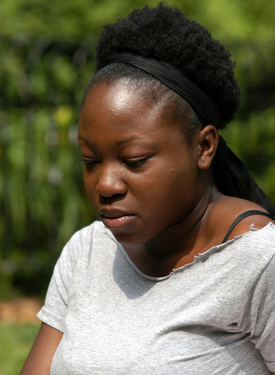When you think about eating disorders what is the image that comes to mind? Is it one of teenaged vanity? Of emaciated white women agonizing in front of the mirror or hunched over the toilet?
 For a long time, the same image of eating disorders was (and for the most part, still is) perpetuated by the media. That image of “too-thin” fashion models, ballerinas and actresses. The one of Karen Carpenter or of Lily Collins in To The Bone. When we Google “eating disorder,” it’s this same image that comes up again and again and while it’s great that we largely becoming more open to the conversation about eating disorders, the conversation shouldn’t start and stop at white women.
For a long time, the same image of eating disorders was (and for the most part, still is) perpetuated by the media. That image of “too-thin” fashion models, ballerinas and actresses. The one of Karen Carpenter or of Lily Collins in To The Bone. When we Google “eating disorder,” it’s this same image that comes up again and again and while it’s great that we largely becoming more open to the conversation about eating disorders, the conversation shouldn’t start and stop at white women.
I am a woman of color with an eating disorder. I have been in recovery for many years now and my journey has not been without obstacles.
My Own Story
I am an immigrant; in my culture, mental health issues and mental illness are overlooked and often met with extreme amounts of denial and shame. Because of this, I had to seek out treatment and navigate my recovery journey on my own, without the support of my family.
I was not able to confide in my family when I was in treatment, nor was I able to access early interventions as a youth, the uniquely vulnerable situation that young immigrants can be faced with despite the love of their parents.
This was not because they didn’t love me. They loved me in every way they knew how. They just didn’t understand because what I needed from them was lost in translation or simply did not exist in their experience back home.
Representation for people who look like me is scarce, which makes it difficult to identify with any messages from the media, even ones that are trying to help.
Often when I hear people speak at eating disorder events, read eating disorder books and articles or watch movies and documentaries, stories do not resonate with me. This is because often, those who are empowered enough to speak publicly about their illnesses come from privileged backgrounds and support from their families. These people have a very different experience with recovery from mine.
For four years, I volunteered and worked in the eating disorder community. In that time, I often found myself to be the only racialized person in the room.
 The vast majority of mental health professionals, organizational management, researchers, board directors were, and still are white folks, mostly white women. These are the people who are in charge of the research, treatment and funding. There is little to no research available on the eating-disorder experiences of people of color and marginalized populations in Canada.
The vast majority of mental health professionals, organizational management, researchers, board directors were, and still are white folks, mostly white women. These are the people who are in charge of the research, treatment and funding. There is little to no research available on the eating-disorder experiences of people of color and marginalized populations in Canada.
All of the mental health professionals I have encountered have been privileged, white women with good intentions but no real grasp on the impact of racism and oppression. While they are often more than willing to discuss family dynamics, they often shy away from unpacking how my experience of covert and overt racism throughout childhood has impacted my body image and self-esteem.
Treatment for eating disorders will always be incomplete without culturally-sensitive body image discussions and interventions.
Being unable to unpack all of the trauma is problematic when trying to heal and navigate the medical system. (I should probably also note that the most recommended, “go-to” book about eating disorders in women of color was written by a white woman.)
Some Crucial Steps Toward Inclusion
If we are going to challenge white supremacy in the world of eating disorders, there are steps we need to take towards true inclusion.
For eating disorder advocates:
Advocate for People From All Backgrounds
Do the people in the room all have the same story, come from the same background and have the same access to support and resources? Eating disorders affect people from all walks of life and there is no hierarchy of who is more deserving of help and healing.
 Include Eating Disorders Other Than Anorexia
Include Eating Disorders Other Than Anorexia
Bulimia, Binge Eating Disorder, OSFED, ARFID etc. are underrepresented and affect many more people than Anorexia yet are not as widely discussed or supported. People struggling with these illnesses have valid experiences and should be advocated for with the same gusto.
Consider What Is Asked of Families
Understand that not all families have the same ability to provide the care and support that is asked for by the western medical system.
Immigrant families, families from lower socioeconomic backgrounds, families that have complicated parental relationships all have children that experience eating disorders. Not everyone has the privilege to take time off of work and in some cases that can mean the difference between accessing treatment for your child or putting a roof over their head.
And for the eating disorder organizations working towards more inclusion:
 Avoid the Tokenization Trap
Avoid the Tokenization Trap
Don’t tokenize marginalized people for campaigns or events in order to appear more inclusive.
Too many times I have felt included in initiatives just to give the illusion of inclusivity and diversity. Symbolic inclusion isn’t inclusion.
Minority groups are not an accessory you can flaunt to make your work look more meaningful.
Involve Those You Wish to Highlight
When working on “diversity” driven initiatives, involve actual members of the minority populations that you want to highlight.
The experts of any story are those who have lived it themselves.
 Employ Marginalized Folks in Key Positions
Employ Marginalized Folks in Key Positions
Pay the marginalized folks that you are collaborating with. Have marginalized folks on your payroll. Have them in leadership positions at your organization. Include them on your board of directors.
Take the time to think about who benefits the most (professionally and financially) from the work that you create. Using diverse voices to amplify your work and not remunerating those contributors is exploitative. It’s thievery.
Create the Right Platforms
So you’ve waved the diversity flag and claim to be inclusive. Are you making it a reality within your organization? What is stopping you from making the space necessary in order for marginalized voices to be adequately heard?
Strive for inclusion by not only highlighting the issues that marginalized people face but by creating space for marginalized people to have a platform.
